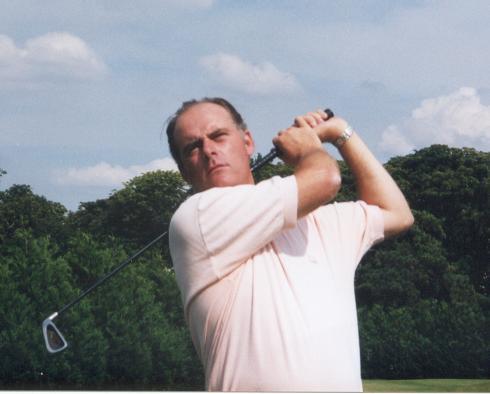
PIN HIGH CLINICS IN ETIOLLES MAY 9th TO MAY
13th
DAY 1 : Monday May 9th
MORNING :
AROUND THE GREEN :
- Working on chipping with 9 iron.
The aim is to feel
that the way to hit the ball is the same whatever be the club. The angle of
the club face makes the ball fly. The swing must be the same as with a putter.
That means the width of the swing is the same on the right-hand side of the
ball and on the left-hand side of it.
Distance :
Distance is given more by the width of the swing than by the speed. To send
the ball further, you just widen the swing without changing the speed of your
shot. The more important is to find the right speed, that means the one you
control the best. We can say that the low part of the swing gives the directio
and the high part gives the distance.
Direction :
Direction of the ball is controlled by the hands. Try to find if you do it
better with the palm of the right hand or with the back of the left one.
- In the rough
The most important to consider is what we
call "the 3 points". When you hit a ball, three "moments" happen.
You touch the ball, you touch the ground and you have the lowest part of the
circle. Those three moments happen at the same time just on the carpet on the
driving range. That means that to make the ball fly from the rough, you must
consider how deep in the grass the lowest part of the circle will be.
That will help you to find and aim the point of entrance in the ground (on the
right-hand side of the ball) .
You can help the lowest part of the circle
to be lower by spreading the stance in the deep grass.
LONG SHOTS ON THE DRIVING-RANGE :
PRESENTATION OF THE METHOD :
To hit a golf ball properly, you need to respect a few fundamental rules :
- The hitting posture is
the same as the starting
posture
- The swing is as symetrical as possible (The
finishing posture is a consequence of the speed, not an obligation)
- The path of the club is the same during the backswing
and the downswing
What is going to be important is the fact that you have to find the points you
have to pass by, instead of the physical way you have to move .
Backswing :The hands are beside the head in front of the neck,
and the shaft of the club is in the same position as it was on the aiming
posture.
Downswing : The hands begin the downswing to send the club and
the body back to the aiming posture.
Hitting area : The feeling to find is an association between the
right hand and the right knee. That is going to help the upper body to be more
steady.
ON THE COURSE :
What I want to make you understand that you don't need to hit wonderfull
shots to score the way you want. You especially need to avoid to miss two
balls in a row, for example.
To do so, you must be more "strategic" than
"technical". That means that you should start with a 7 iron or a 5
iron, but not absolutely with a wood.
Advice of the day :
* Do some practice swings before playing
* Test the grass (don't do practice shots without hitting the ground)
* Beware your aiming posture
* Put the ball higher on the tee to swing easier
* Swing shorter whenyou are close to the green. Just try to send the ball on
the green.
* Don't think about the distance to reach, think about the impact area.
DAY 2 : Tuesday May 10th
WARM
UP :
What is
important in the warm up is to prepare your swing. That means you have to
prepare some particular parts of your body to do the swing.
- Shoulders (to help your arms to swing easier)
- Neck (for the steadiness of the upper body)
- Spine
- Legs
AROUND THE GREEN :
Chipping
with 9 iron or 7 iron :
- The swing must look like a clock. We saw that you can
imagine three widths for the swing :
* 7 to 5
*
8 to 4
* 9 to 3
Posture :
There is a difference between the posture of the long shots and the one on the
short game. As you stand far from the ball on long shots and very close on
putting, you have to adapt your posture (especially the distance from the
ball) to the short game.
* Hold the club shorter
* Get closer to the ball
* take a smaller stance
The width of the swing depends on the speed you hit the ball. If the swing
is slow, it is better to swing 9 to 3. If the swing is faster, 7 to 5 will
be enough.
- The choice of the club depends on the trajectory you
want to give to the ball. If you prefer to make the ball roll, 7 is better.
If you prefer it to fly, 9 or even SW will be allright (PW too).
The shot looks like the previous one in the deep grass. To play better in
the bunker, you have to feel that there is no difference between deep grass
and sand.
Posture :
* Hitting line in the middle of the stance
* Weight on the left by burying the left foot
* Club open so that the perpendicular to the club face is aiming over the
wall
Swing :
* The backswing is wide to have enough power to go through the sand and make
the ball fly
* The club must enter the sand behind the ball
* You have to finish the swing to help the ball to fly
The fact is that you have to consider that if you send the amount of sand
surrounding the ball on the green, the ball will get out of the bunker with
this amount of sand.
LONG SHOTS ON THE DRIVING RANGE :
"ORDER OF THE THINGS" :
THE BACKSWING : We are going to build the
backswing according to the impact zone, and the way we want the club to hit
the ball. That means through the ball instead of downwards. The set up is
the following way : PUTTER STARTING / SET UP OF THE CLUB PATH / RAISE OF
THE HANDS.
Putter starting : We star the backswing the way
we start the the putter shot, that means without wrists, not to load too
fast. the fact to load the wrist makes the strike too much vertical (so
you're going to hit the ground). That is better for short clubs.
Set up of the club path : After that putter
start, we load the wrist to put the club parallel to the ground and towards
the target. The club is so on the same line as the line followed by the
hands during the "take away".
Raise of the hands : At this moment, you just
have to raise the hands according to the shot you wish to involve the
shoulders rotation.
The "important things" at that
point of the swing are : left arm parrallel to the ground and the shaft
making an angle of 90° with the left forearm.
AFTER THE BALL :
We'll find on the other side the same path as during the
backswing. You're so going to hit the ball the "putter way", the
wrist being unloaded during the downswing instead of during the strike
because of the lack of power. The club will come back parrallel to the
ground (as you did in the backswing), and you're then going to raise the
hands to the "technical finish" (the right knee follows). Te
"Physical Finish" will follow, according to the speed of the
swing. You don't have to do the physical finish. It is the technical
finish (perfect symetry between the backswing and the follow through) which
is important and on purpose. It will be so possible to increase the speed of
the strike without increasing the width of the swing.
The "important things" at
that point of the swing are : right arm parrallel to the ground and the
shaft making an angle of 90° with the right forearm.
Dont't forget the exercise of the shadow. When you
swing facing your shadow, the head of the shadow is not supposed to move.
For the moment, the aim is to take an average of two putts
per green. To be able to do so, you must respect a few elementary rules :
* Eyes upon the ball
* Legs stiff and steady
* No wrists use
* Slow swing (distance is given by the width of the swing)
Aiming is easier if you align the name of the ball towards the target (the
hole or the slope)
Our advice of the
day is about the way to change the distance made by the ball.
Two ways :
* According to the stance. That means you swing between or wider than your
feet to make more or less distance
* Changing the stance so that you spread more or less to swing more or less
wide.
AFTERNOON ON THE COURSE :
We saw that today was much better than yesterday because you began to trust
yourself. Your swing is improving because of the details we've been working on
since yesterday.
Anyway, the most important is to keep on trying to feel that every shot is the
same. You hit every ball the same way. Just the width and the speed of the
swing change.
DAY 3 : Wednesday May 11th
SHORT GAME :
You have to work on the accuracy
of your chipping. The right average should be "one chip / one
putt". On chipping beware the slopes. The putting advice of the day was
about the "br(e)ake(e) point". We called it that way because it is
the point where the ball turns the most and looks like loosing its speed (to
turn).
The advice of the day was about the way to find the right
"br(e)ak(e) point". You first have to lok around the hole to
know where the ball will come from to enter the hole. To pass by this
point, you have to reach another point, more into the slope. That last
point is the "br(e)ak(e) point".
Put a coin down on the green to
aim this point and forget the hole. Anyway, the target is almost never the
hole itself. Most of the greens are too much sloppy for that.
ABOUT THE HITTING AREA :
To be able to play longer clubs, it is
important that you understand what is the real difference between long and
short clubs. The first thought is about the length of the shaft. I think
the problem comes more from the size of the sole of the club.
We said that when you need about 6 cm to
make the club go through the ball on an iron, you will need at least 20 cm
with a wood. That is why we described the impact zone as if you have three
balls to hit at the same time. To be able to follow this "3 balls
line", your hands must do their job during the impact (staying lower
longer), but your left knee has to be more steady. It is the fact to move
this knee backwards while hitting the ball which make it fly in the wrong
direction or being topped.
ABOUT THE WOODS :
The first thing is to admit that you don't need to play woods
to score about 7 or 8 per hole. You have to play the clubs you control
- The main difference is in the distance from the ball. As the swing will
be wider and faster down, the strike will happen "higher" than
usual, that means a few centimeters over the ground. If the club lies just
behind the ball, you will hit the ball in the heel of the club. So you're
going to miss the ball. You have to set up with the club
"beside" the ball. Just lifting the hands up, you see that the
club face is perfectly against the ball. So you can find it easier during
the downswing.
- The rythm of the swing must be always the same. The fact to miss the
ball comes more from an uncontrol of the impact zone than from a wrong
swing. So don't try when you miss to analyse the way you moved your body.
Try to think about the way your hands were during the impact zone. Correct
by ajusting the height or the accuracy of the club path.
- The posture is your own. It depends on the size, the elasticity of the
body, the weight and many other things.
- The notion of "throwing" or "hitting" give the
height of the tee. The hitter will put the ball lower and less on the
left-hand side, and the thrower will putt the tee higher and more on the
left.
AIMING :
- Take
a point between the ball and the target not further than 50 cm from the
ball
- Align
the club face toward that point
- Place
your body parrallely to this line
The best feeling is when you feel like being aligned toward the left of
the target.
The problem, when you don't aim the right way, is that you sometimes send
the ball in the wrong direction, but most of the time you correct the
alignment by moving your body during the swng and that makes you miss the
ball.
DAY 4 : Thursday May 12th
CHIPPING AROUND THE GREEN :
Always the same as every day. The
aim is to find the right rythm, the right speed and the right contact with
the ground. The fact to send the ball close to the hole is not very
important. What is important in your first balls of the day is the way you
hit the ball.
From the rough with SW :
Two ways
to play the ball
- Take the usual position, club a few centimeters behind the ball. Put the
weight on the left foot (for right-handed) with bending your body
to the left. Swing the club through the grass without using the wrists.
- Put the ball in front of your right foot (for right-handed), the weight on
the left and let the club hit the ground behind the ball. The ball will
jump, but it will be very difficult to control it.
About the
posture :
- Legs steady
- No wrists
- Plan of the swing very "vertical" (because you don't need to
turn your shoulders)
On the sloppy green :
Try to
work your aiming with putting two clubs on the ground in the direction of
where you want to send the ball. You have to follow the line of the club
shafts. 7 iron is the best club to play, because you don't need to make the
ball fly. Beware the slopes because they change the angle of the club.
ON THE DRIVING RANGE :
THE SIX PARTS OF THE SWING :
Set Up : *
Bent forward
* Arms hanging
* Knees a little bent and weight on the toes
Take Away : * Club
parrallel to the ground and the flight line
* Wrists almost loaded
Backswing : * Hands up
* Shoulders following
* Weight on the right foot
* 90° between club shaft and left arm
Hitting : *
Club goes back to the ball
* Body goes back to aiming position
* Weight is back in the middle of the stance
Follow Through : * Club parrallel to the
ground in the direction of the target
* Weight on the left leg
* Right knee beside the left one
* Right foot up on his toe
* Arms straight
Finish : *
Club falls on the shoulders
* Body turns toward the target
DAY 5 : Friday May 13th
Today is a relaxing day. We've been working a lot this
week and I think that you all improved your acknowledges and your swing.
Now you need to gain confidence in yourself by playing more and more.
To finish our clinic, the best way is to have an
individual report on what you're supposed to work in the future. So I hope
these pictures will help you to do so.
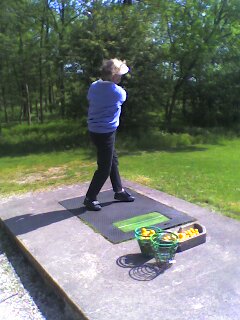
 |
Comme on peut le voir, le swing pourrait
être plus large. Sur la première image, on peut voir le pied droit
encore collé au sol, ce qui empêche les bras de s'allonger vers
l'objectif. On en voit d'ailleurs l'exagération sur la seconde
image, avec un perte d'équilibre vers l'arrière. Il faut penser à
avancer avec la balle. |

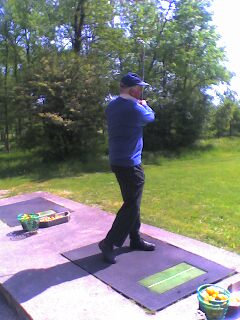 |
Comme je vous l'ai expliqué, le swing
s'est rétréci en devenant plus vertical que transversal. Il faut
retravailler la zone d'impact et donc donner plus de transversalité
au swing. Tout le discours de la semaine fut en rapport avec cette
zone de frappe et la sensation de contrôler le club tout au long de
cette zone. |

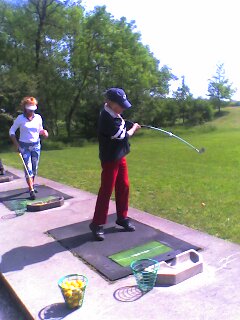 |
The problem is in the difference between
the backswing and the follow through. The position on the backswing,
as you can see, is perfect (you could load the wrists a little
more), but at the moment you hit the ball, you can see the arms
against the body instead of spreading towards the target. Kepp on
working on that point. |

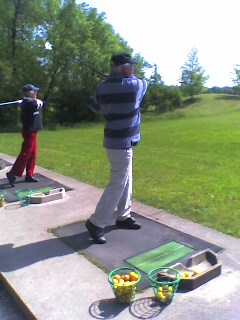 |
As I told you, the backswing is quiet
good. Just take care of your right legs which is sometimes
stiffening and moving to the right. On the second picture, the right
foot could be more "up", that means the weight transfer is
not completed. Keep on straightening your arms towards the target to
help the weight to transfer. |

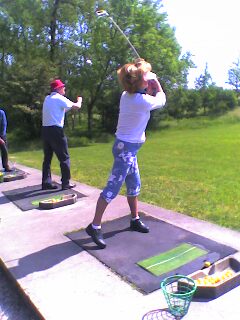 |
I think the week was a big benefit for
you, and you had the best improvement. As I told you once, at the
beginning it was o motion and now it is a swing. You just look a
little stiff on your legs, but the good thing is that you try to
widen the swing. Keep on straightening your arms towards the target
and "trust" the grass. |
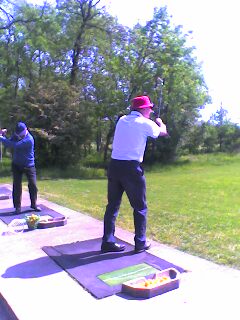
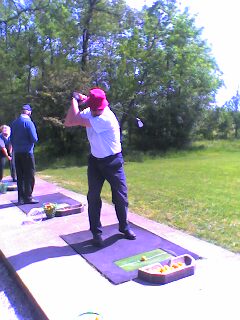 |
The main problem was on the fact to move
your feet as you can see on the first picture. I think you're able
to swing your arms without moving your feet. The backswing is quiet
good (shoulders turned, legs are still relax and the head didn't
move). The advice I gave you was about the wrists that you sometimes
use too much. |
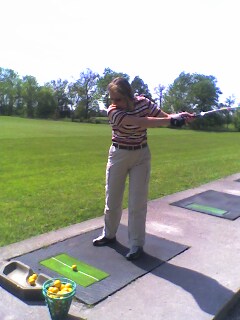
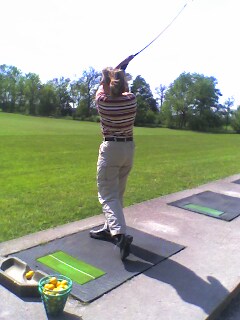 |
You could load the wrists on the
backswing to gain a little power and so not use your body to hit the
ball. We can see that the finishing position is good (weight on the
right foot, arms up, facing the traget). My main advice was to stay
low to allow the club to go through the grass and make the ball fly. |
|


|
Backswing, as I told you, is perfect. Just
beware the plan of the swing on short shots. You just have to trust
the follow through (as you can see on the second picture, your arms
are not straight while hitting the ball). Work on the weight transfer
and control your hands while hitting. |
I want to tell you that I enjoyed a lot to work with all of you and I hope
to see you again in another PinHigh location
TOT ZIENST !
Home













